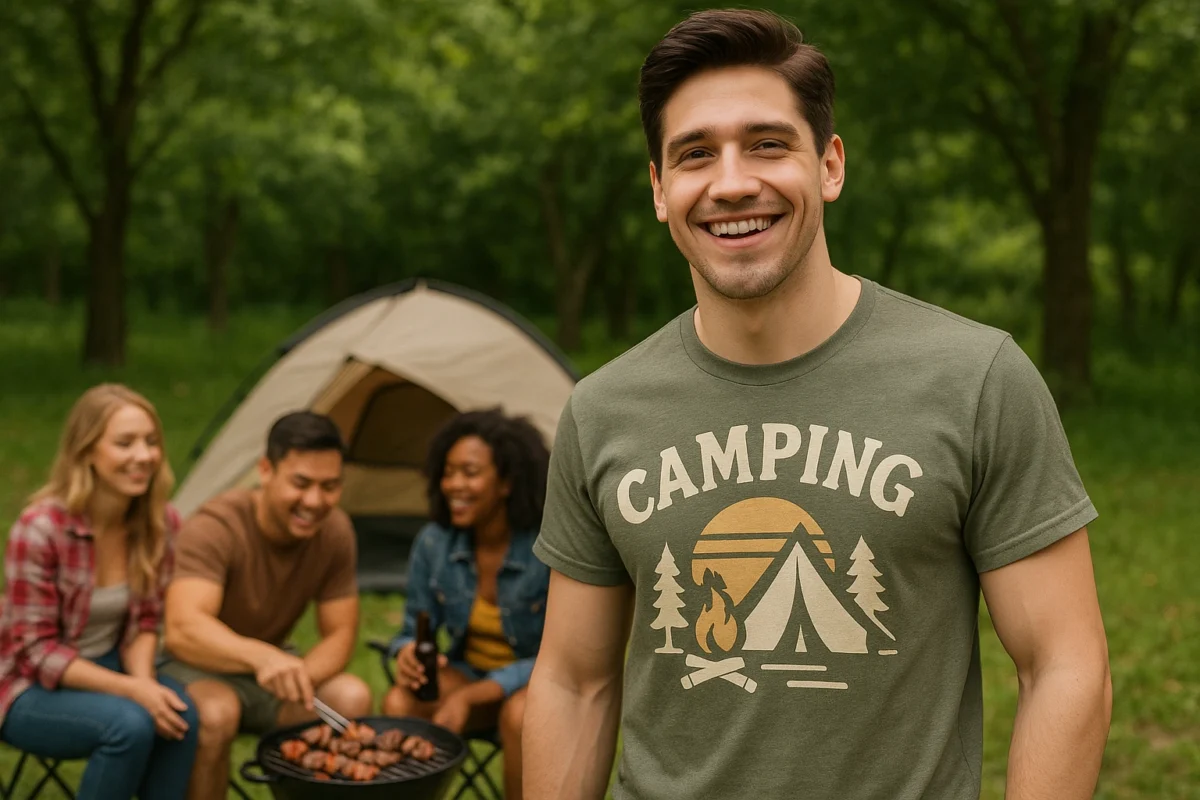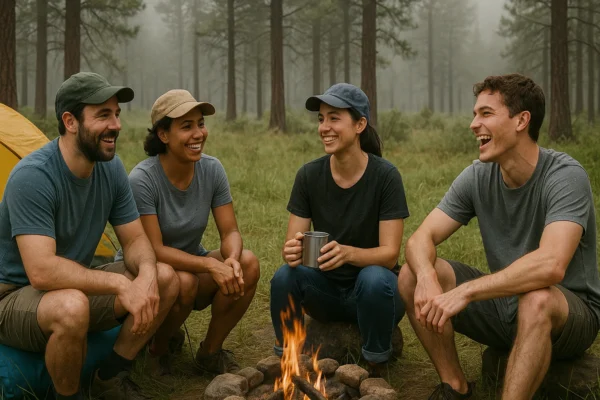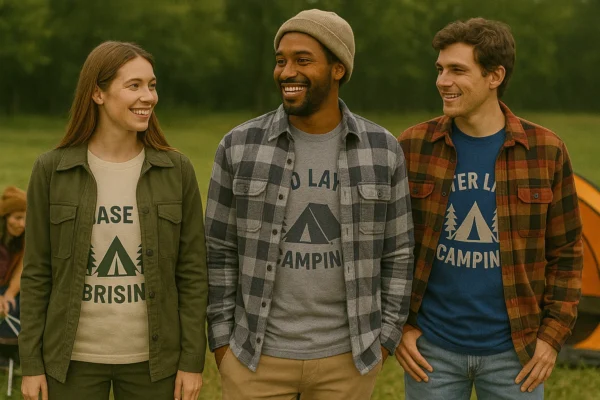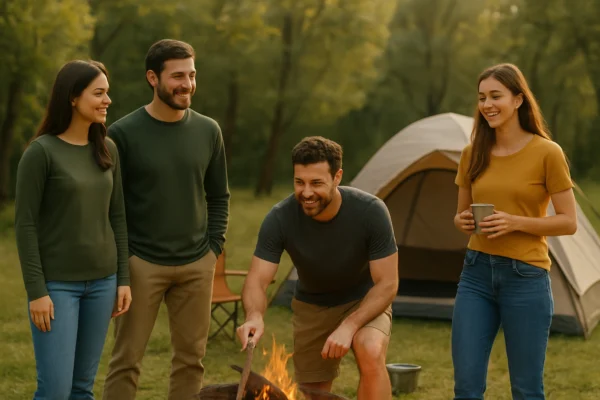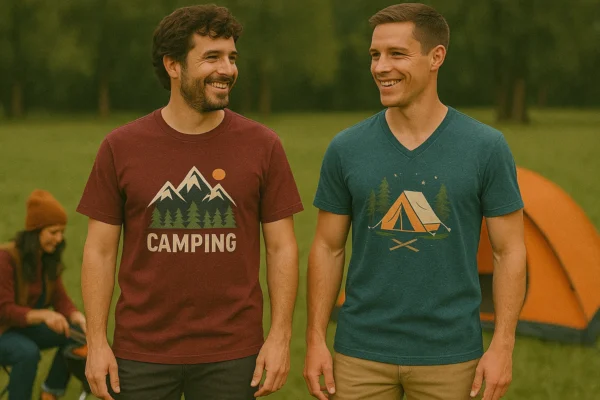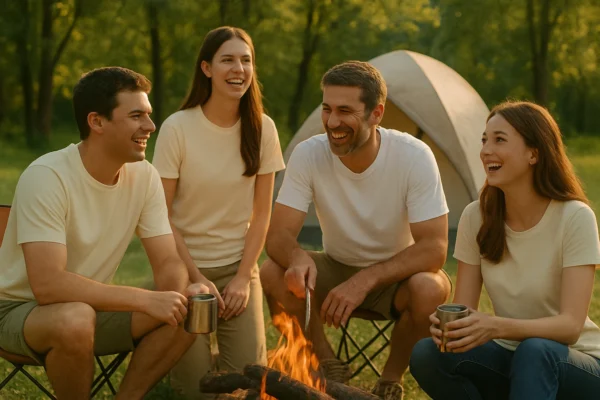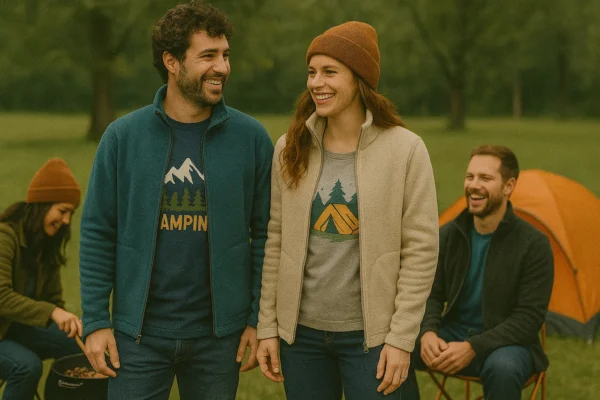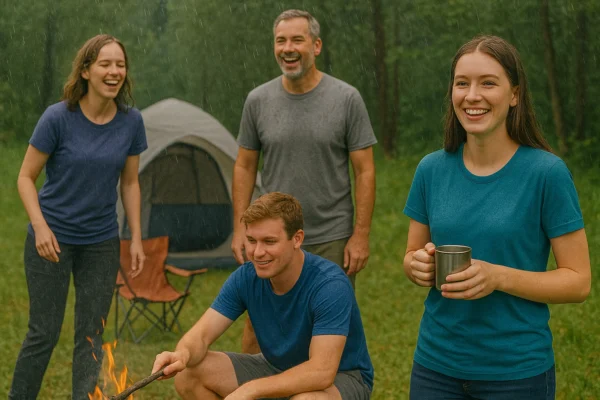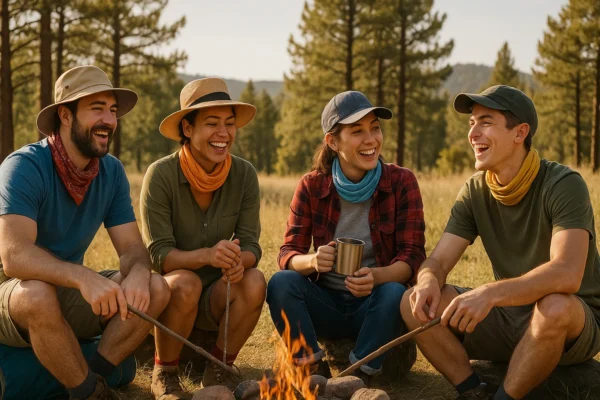Smart Packing: Choosing the Right Camping T-Shirt
Choosing the right T-shirt might seem like a small detail, but when you’re out camping, it can make a huge difference. The wrong shirt can leave you sweaty, chilled, or uncomfortable, while the right one keeps you dry, cool, and ready for adventure.
In this guide, we’ll cover what to look for in a great camping T-shirt, from moisture-wicking fabrics and breathability to sun protection and quick-drying performance. Whether you’re a casual camper, weekend hiker, backpacker, or festival-goer, having the right base layer can level up your whole experience. If you’ve ever packed too much or too little, or ended up in a damp cotton tee, you’ll know how valuable a smart T-shirt choice really is. Let’s help you pack smarter.
Why Your Camping T-Shirt Is More Important Than You Think
You might not think much about it, but your T-shirt is one of the hardest-working pieces in your camping wardrobe. It’s often the first thing you put on in the morning and the last thing you wear before crawling into your sleeping bag at night. That means comfort, fit, and function aren’t just nice to have: they’re essential.
A good camping T-shirt plays a key role in your layering system. In warm weather, it’s often your main top, keeping you cool and dry as you hike, cook, or chill around camp. In colder climates, it acts as a breathable base layer under fleece or a jacket, helping regulate temperature and wick away moisture. And if you’re sleeping in a tent or under the stars, you’ll want something soft, non-restrictive, and temperature-appropriate.
It’s also about climate adaptability. Heading somewhere hot and humid? You’ll want a lightweight, moisture-wicking synthetic or merino blend that dries quickly and keeps odor at bay. Cold or variable weather? Go for merino wool, which insulates even when wet and won’t leave you feeling clammy. Avoid heavy cotton in damp environments; it dries slowly and holds sweat, which can make you colder and more uncomfortable.
The right T-shirt doesn’t just add comfort: it adds versatility. One well-chosen T-shirt can carry you through a full day outdoors, from hiking the trails to relaxing by the campfire and even getting a good night’s sleep, all without taking up extra room in your pack. That’s why it’s worth choosing carefully.
5 Key Features to Look For in a Camping T-Shirt
Not all T-shirts are created equal, especially when you’re living out of a backpack or spending days off-grid. When choosing a camping T-shirt, it’s less about style and more about function: how it performs in the elements, how it feels after a few miles on the trail, and how it handles sweat, sun, and wear. Here’s what really matters:
Fabric Type: Natural vs Synthetic vs Blends
Merino wool is a favorite among seasoned campers and backpackers for good reason. It’s naturally odor-resistant, breathable, soft on the skin, and it insulates even when damp, making it ideal for variable weather and minimal washing. It’s great for both warm and cool climates.
Polyester blends are another solid option, especially if you’re on a budget. They dry fast, feel light, and often include moisture-wicking technology. While they’re not quite as odor-resistant as merino, many come with anti-microbial finishes to help with that.
Cotton is comfortable and breathable, but it’s not the best choice for camping in wet or humid conditions. It soaks up moisture, takes a long time to dry, and often leaves you feeling damp and uncomfortable. However, a soft cotton tee can be nice for lounging or sleeping on dry-weather trips.
Moisture-Wicking & Breathability
Moisture-wicking is a must-have feature in any camping shirt. The fabric draws moisture off your skin and spreads it across its surface, so it dries quickly and helps you stay comfortable. This keeps you cooler and drier, especially during physical activities like hiking or setting up camp.
Breathability goes hand-in-hand, it allows air to circulate, reducing the risk of overheating or trapped moisture, particularly under layers or a backpack.
Odor Control & Anti-Microbial Properties
Honestly, chances are you’ll wear the same shirt several days in a row during your trip. Shirts made from merino wool or treated synthetics help prevent odor buildup, thanks to their natural or engineered anti-microbial properties.
Staying odor-free isn’t only about comfort — it’s essential for hygiene when washing clothes isn’t possible.
Sun Protection (UPF Ratings)
If you’re spending long hours outside, especially in sunny or high-altitude areas, built-in UPF (Ultraviolet Protection Factor) is a smart feature to look for.
A rating of UPF 30–50+ means the fabric helps block harmful UV rays, reducing the need for sunscreen under clothing and adding peace of mind during sun exposure.
Lightweight and Quick-Drying
Camping is all about packing smart — and every ounce counts. A lightweight, compact T-shirt that dries quickly can be worn, washed, and re-worn easily on the go. This is especially important for backpackers, thru-hikers, or travelers with limited space.
Look for shirts that can air dry within a few hours — ideal after a creek dip or camp sink wash.
How to Choose the Right Fit and Style for Your Camping T-Shirt
Choosing the right fit and style for your camping T-shirt goes beyond looks—it directly impacts your comfort and performance outdoors. Here are key points to help you decide what works best for your next adventure:
Loose Fit vs Athletic Fit
A loose-fitting T-shirt promotes better airflow, keeping you cooler on hot days and giving you room to layer underneath if needed. It’s ideal for relaxed camp days or activities that don’t require intense movement. Plus, it offers freedom of motion and doesn’t cling to your skin, which can be more comfortable in humid or buggy environments.
On the other hand, an athletic or slim fit shirt hugs the body, which reduces friction and stays close during active pursuits like hiking, climbing, or cycling. This fit can also help retain warmth in cooler weather by trapping a thin layer of air close to your skin.
Long-Sleeve vs Short-Sleeve
Long-sleeve shirts offer excellent protection against sunburn, insect bites, and cooler temperatures. Many designs feature roll-up sleeves, giving you the flexibility to adjust as the weather changes throughout the day. Meanwhile, short-sleeve shirts are great for hot and dry conditions, helping you stay cool and unrestricted during vigorous activity.
Packing both options can be a smart strategy, letting you layer or switch depending on the environment and time of day.
Crew Neck vs V-Neck: Style or Function?
Crew necks provide fuller coverage around the neck, offering better protection from sun and wind. They also layer nicely under jackets or fleeces without gaps.
V-necks, by contrast, tend to feel more open and breathable, which some campers find more comfortable, especially when temperatures rise. They can also add a casual, stylish vibe when you’re relaxing around camp or heading into town.
Ultimately, the choice between crew and V-neck often comes down to personal preference, but either can perform well as long as you choose the right fabric and fit.
How to Pick the Best Camping T-Shirt for Any Weather
The weather can make or break your comfort while camping, so picking the right T-shirt for the conditions is essential. Here’s how to tailor your choice to stay comfortable no matter what the forecast says.
Hot Weather Camping
When camping in hot weather, prioritize breathability and lightweight fabrics. Look for T-shirts made from technical materials that offer ventilation panels or mesh inserts to promote airflow and help you stay cool.
Light-colored shirts reflect sunlight better than dark colors, reducing heat absorption. Short sleeves are ideal for maximum ventilation and ease of movement during active days.
Cold Weather Camping
For cold-weather trips, layering is key, and Merino wool base-layer T-shirts are a top choice. Merino wool naturally insulates while remaining breathable and retains warmth even when damp.
Pair your Merino base layer with fleece or thermal layers to create a flexible system that can be adjusted as temperatures fluctuate during your adventure.
Rainy or Humid Conditions
In damp or humid conditions, cotton tends to hold onto moisture and takes a long time to dry, which can make you feel sticky and uneasy.
Synthetic blends such as polyester or nylon dry quickly, wick moisture effectively, and pack down compactly. Bringing extra shirts to swap out after rain or sweat can help maintain freshness and comfort on multi-day trips.
The Perfect Number of T-Shirts to Bring Camping
Packing light is a camping superpower—carrying less means moving easier and enjoying more. When it comes to T-shirts, finding the right balance between enough and too much can save both space and hassle.
For most camping trips, bringing 2 to 3 technical shirts is ideal. These shirts are designed to wick moisture, dry quickly, and resist odors, which makes them perfect for active days on the trail. You can wear them repeatedly without discomfort, which means you don’t need to overpack.
In addition to your technical shirts, pack one comfortable cotton T-shirt for lounging around camp or sleeping. Cotton feels soft and cozy, great for relaxing after a long day, but remember it’s not the best for sweaty activities since it retains moisture.
This mix lets you stay comfortable and fresh without carrying unnecessary weight. Plus, with quick-drying technical shirts, washing and drying on the go becomes easier if your trip is longer.
How to Style Your Camping T-Shirt for Comfort and Function
Camping doesn’t mean you have to sacrifice style for function. With a few smart choices, your camping T-shirt can be part of a versatile, comfortable outfit that works from trail to tent.
Pairing with Hiking Pants, Thermal Layers, or Fleece
A good camping T-shirt is your base layer and foundation. Pair it with durable hiking pants that offer mobility and protection: think quick-drying, stretch fabrics that handle rough terrain.
On colder days, layer your T-shirt under a lightweight fleece or thermal jacket for added warmth without bulk. This layering system keeps you comfortable during temperature swings and outdoor activities.
Accessorizing with Scarves, Buffs, and Hats
Accessories aren’t just for style: they add practical benefits, too.
Lightweight scarves or buffs can protect your neck from sun exposure or keep bugs at bay. A wide-brimmed hat or a breathable cap offers crucial sun protection and helps keep you cool. These simple extras complete your look while boosting comfort and safety in the outdoors.
Wrap-up: Finding the Best T-Shirt for Your Camping Trip
Choosing the right camping T-shirt boils down to comfort, functionality, and adaptability. Whether you’re trekking through humid forests, relaxing by the campfire, or layering up in chilly weather, your T-shirt plays a crucial role in keeping you comfortable and protected. Prioritize technical fabrics that wick moisture, dry quickly, and offer sun protection, but don’t forget the value of a cozy cotton shirt for downtime.
Remember, there’s no one-size-fits-all solution—your best camping gear is the one that suits your specific trip, activities, and personal preferences. Packing smart means fewer worries and more time enjoying the great outdoors.
So take what you need, keep it versatile, and trust your choices to help you make the most of your camping adventure. After all, the right T-shirt isn’t just clothing—it’s a part of your camping experience.

